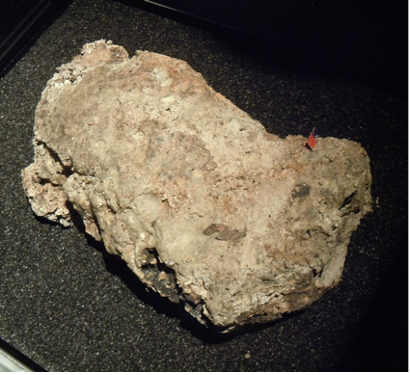Competency F1: Test and Service Sanitary and Storm Drainage Systems
Learning Task 2
Describe Troubleshooting and Repair of Drainage, Waste, and Venting (DWV) Systems
Regular maintenance of a drainage, waste, venting, and storm systems will help prevent problems. However, it is inevitable that issues will arise. When called out for service, there are different ways to troubleshoot and repair system issues.
The goal of troubleshooting is to determine why something does not work as expected and then repair the problem. The first step in the troubleshooting process is to verify the faults in the system. Some common faults are:
- Tree roots
- Settling
- Physical damage
- Fatbergs
- Pipe failure
- Human Error
Faults
Tree roots
Trees and shrubs are a great addition to your landscape, providing fresh air, beauty, and shade when mature. However, uncontrolled root growth under the ground can cause them to quickly encroach on your sewer lines, resulting in thousands of dollars worth of damage to your plumbing system. Tree roots may also infiltrate a septic system and cause damage and drainage troubles.
When tree roots have invaded your drainage system, depending on the extent of damage, there are only so many options for repair. Broken pipes must be dug up and replaced. However, in some cases companies can feed a new pipe through the existing one eliminating the need for the system to be dug up and possibly saving the occupant money.
Settling
There are several reasons why a building’s foundation is settling. One of the most common reasons foundations settle is because the soil underneath wasn’t correctly compacted before construction began. Material that was buried underneath your foundation could start to degrade, leaving behind voids or pockets. Or the soil underneath your foundation is made of too much clay, which is expanding and shrinking based on moisture content.
Settling can cause pipes to lose their grade and begin to backflow. Placing a level on the lowest piping could indicate if this is the reason for trouble. Also, you may see cracks in the building’s foundation signifying that settling has occurred.
Once settling has been discovered, back grading pipes must be fixed. In many cases, the pipes must be dug up, relevelled, and backfilled or backups will continue.
Physical Damage
Most of the DWV system is vulnerable to physical damage. Damage is caused by things ranging from cars to rodents. Natural movement in the system as water flows and movement caused by vehicles driving near pipes can, overtime, loosen clamps and create damage and leaks. Small cracks become larger and leaks and pipes become clogged with pest infestations.
If pipes have been broken due to physical damage, they will need to be replaced. A pest infestation may require more than a service plumber to fix the problem, but the pipe must be cleared of an infestation to restore proper draining.
Fatbergs
Fatbergs are large lumps of fatty gunk in the sewer system which can set as hard as concrete. They are caused by fat, oil and grease being disposed of incorrectly down sinks and drains, and then accumulating over time.
Once found, removal of a fatberg is difficult. They become hard and dense and must be chipped away with shovels or high-pressure water jets. They can be broken down into smaller pieces that float away to the nearest sewer or they are removed manually with buckets.

Pipe Failure
General corrosion and sediment build-up can create leaks and blockages. Natural soil movement over time causes sagging sewer lines, which can become a problem when the low spots create repeat blockages, ruptures, or leaks. Maintenance will help extend a DWV system’s lifespan, but eventually parts of it will require repair or replacement.
Human Error
One thing to keep in mind is that a toilet is not a garbage can. People will toss just about anything down the drain with the predictable consequence being a clog. Kitchen sinks clog with grease and egg shells, while toilets can clog with toys and remote controls. Flushable wipes have become a recent culprit of clogs in the DWV system. Customers should be advised that nothing should flushed down a toilet other than toilet paper.
A service plumber must locate and clear blocks in the drainage piping by means of a camera inspection, auger, hydro jetter, or any other equipment necessary.
Troubleshooting Checklist
When responding to a service call for a DWV system, here are some things to try and look for to help troubleshoot the problem:
- All drains are backing up at once. When the toilet is flushed, the toilet, sink, and showers all start to overflow, there is a clog in a main pipe somewhere
- When the toilet is flushed the water is bubbling or gurgling. This can indicate a partial blockage.
- Indentations in the yard may indicate a break in the line or a sagging pipe. Changes to grass are also an indicator of sewer leaks. Soggy patches or extra green patches of grass could mean sewage is coming up from the pipes below and fertilizing your lawn
- Smell. If it smells like sewage, it’s probably sewage
- Mold. Leaking sewage pipes mean moisture in places you don’t want moisture. This can cause fungi and mold to grow in seemingly strange areas of a home. If there are mold spots, look for other signs of sewer damage
- Drains are slow. If the drains are slow, it could be the start of a larger clog
- Pest infestation. If there is evidence of a rodent infestation, rodents could be coming in from the sewage pipes
Safe Work Practices
Safety
Drains and sewer can carry bacteria and other infectious micro-organisms or materials that can cause death or severe illness. Avoid exposing eyes, nose, mouth, ears, hands and cuts and abrasions to wastewater or other potentially infectious materials during drain and sewer cleaning operations. Safe and effective use of drain-cleaning equipment requires service personnel to use personal protective equipment (PPE) while working on sewer or drain lines.
Two important safety items essential to drain cleaning are:
- Safety glasses or goggles with side shields
- Gloves
- Eye protection is an important safeguard against flying solid objects or pathogenic liquids, which can become airborne when the tension on a cable is suddenly released. Gloves protect a technician’s hands from sharp objects and are especially important for the hand that guides the cable into and out of the drain. Sudden release of a stoppage causes the cable to spin rapidly enough to burn or cut bare hands.
Service personnel also need to be aware of the risks presented by ponding water from backed up drains. One good safety practice is to stand on boards or a solid pallet to prevent electrical shock from grounding through water. As with any power tool, always check the safety features of the equipment provided by the manufacturer before taking it to the job site.
Since drain cleaners can suddenly hit blocks or stoppages, you should never force them through the blockage. The best practice is to use short forward and reverse movements of the cable to prevent jamming and breakage. The cable drum should be cleaned before it is returned to storage because bacteria and pathogens can be transferred during handling even after the job has been completed.
Confined Space
WorkSafeBC defines a confined space an enclosed or partially enclosed area that is big enough for a worker to enter. The space may be enclosed on all sides (for example, a bin or tank), or as few as two sides (for example, an enclosed conveyor). Confined spaces are not designed for someone to work in regularly.
A sump or septic tank are both examples of confined spaces and should not be entered without the proper training.
Test and Return to Service
In accordance with the NPC, any design, installation, extension, alteration, renewal, or repair of a plumbing system must satisfy the testing requirements. Before returning a system to service you must ensure that it is properly tested.
Drainage Tests
Water Pressure Test
A water pressure test shall consist of applying a water column of at least 3 m (10′) to all joints. In making a water pressure test, every opening except the highest shall be tightly closed with a testing plug or a screw cap, and the system or the section shall be kept filled with water for 15 minutes.
Air Pressure Tests
Air pressure tests shall be conducted in accordance with the manufacturer’s instructions for each piping material. Air shall be forced into the system until a pressure of 35 kPa (5 psig) is created, and this pressure shall be maintained for at least 15 minutes without a drop in pressure.
Final Tests
Where a final test is requested and made, every trap shall be filled with water, and the bottom of the system being tested shall terminate at a building trap, test plug or cap. Smoke from smoke generating machines shall be forced into the system, and when the smoke appears from all roof terminals they shall be closed. A pressure equivalent to a 25 mm (1″) water column shall be maintained for 15 minutes without the addition of more smoke. The smoke referred to above may be omitted provided the roof terminals are closed and the system is subjected to an air pressure equivalent to a 25 mm water column maintained for 15 minutes without the addition of more air.
Ball Tests
Where a ball test is conducted, a hard ball dense enough not to float shall be rolled through the pipe. The diameter of the ball shall be not less than 50 mm (2″) where the size of the pipe is 75 mm (3″) or more, or 25 mm where the size of the pipe is less than 75 mm.
 Now complete Self-Test 2 and check your answers.
Now complete Self-Test 2 and check your answers.
Self-Test 2
Self-Test 1
Media Attributions
- Figure 8. “Dried Fatberg found in London sewer” by Lord Belbury on Wikimedia Commons is licensed under a CC BY-SA 4.0 licence.

